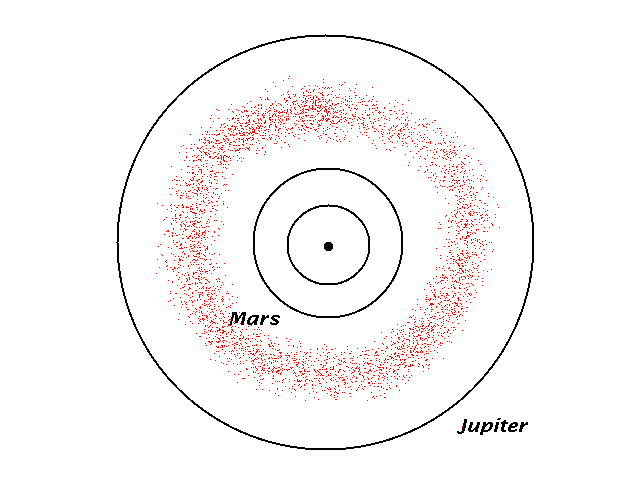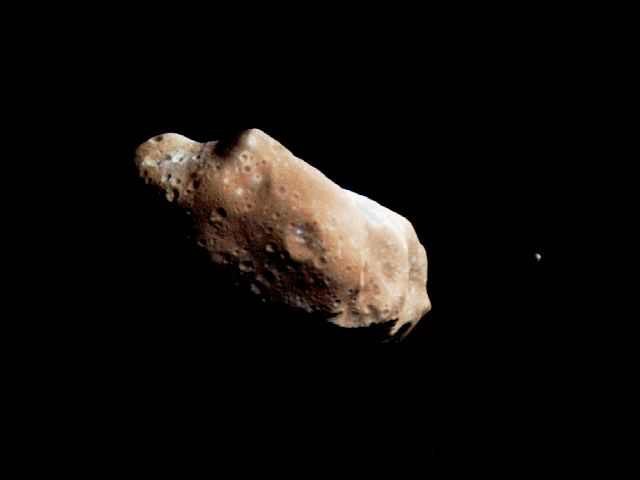Asteroids and Meteorites
Asteroids
Between Mars and Jupiter there is a belt of rocks.

Is this a planet that didn't form?
Maybe so. Jupiter's gravity may have been too much of a disturbance.
But it would have been a little planet. Astronomers estimate total mass of the rocks to be about 0.0005 Mearth.
Here is one of the larger asteroids, named Ida. It has a little
moon, Dactyl:

Meteorites
From time to time, a rock falls from space and hits the earth. Such rocks
are called meteorites. Astronomers distinguish between a meteorite and
the same thing that has not collided with Earth, calling the latter a meteoroid.
When a meteoroide falls to earth, it heats up in the atmosphere and leaves
a trail of glowing molten rock. We see that and call it a meteor. Small
rocks are simply destroyed by the atmosphere and never hit the earth. But
some bigger ones do.
A big meteorite can make a crater. For instance, there is a meteorite crater in Arizona. Of course, we
know that this sort of thing can happen at other places besides the earth.
We also know that there are a lot fewer meteoroids around than there used
to be: recall that most of the damage to the moon was done in the
first half billion years, so that the maria are relatively crater free.
This suggests that of the rocks that
were originally in orbits that intersect with Earth's orbit, most have
had their orbits perturbed so that they crashed into the sun or they have
been swept up by Earth (or maybe by Mercury, Venus, or Mars).
But if that is right, where are the present meteorites coming from?
The obvious theory is that most are coming from the asteroid belt.
- The asteroid belt would be expected to be full of lots of rocks of all sizes.
- Interactions with Jupiter's gravity can send some of these rocks into
orbits that intersect Earth's orbit.
There are some other sources:
- Some come from comets that have broken up. In fact, these can make
meteor ``showers'' in which there are lots of meteors over a few nights and they all come from the same direction.
- Some can be identified as moon rocks.
- A few have been identified as probably having come from Mars. (Something big hit Mars and blasted Mars rocks into space!)
What can we learn from meteorites?
Meteorites offer clues about the formation of the solar system.
Some have been part of large bodies planets or moons. This is
especially true of ``iron meteorites'' which are made of iron and
nickel. Material that was in the original solar system must have been
collected into a big body and melted. Then the iron and nickel could
settle in the middle and the lighter rocks could float on the outside.
That way you could get iron rocks if the large body were smashed in a
collision.
Some are much more primitive. That is, they appear to have been made
of rock that condensed from the original solar nebula and was not
processed by being part of a large moon or planet. (Nevertheless they
appear to have been processed to some extent in asteroids.)
We can learn:
- The age of the solar system.
- Astronomers use radiometric dating to determine the time since the rock crystalized.
- Meteriorites provide the oldest rocks found.
- The Allende meteorite (see picture in Fix) is measured to be 4.563
billion years old (with an uncertainty of 0.004 billion years).
- Other meteorites give similar ages.
- This is consistent with the ages of the oldest moon rocks, 4.45 billion
years, and of the oldest Earth rocks, about 4 billion years.
- It is significant that this is all consistent: if, say, the oldest
Earth rocks were 2 billion years old and the oldest meteorites were
0.02 billion years old, that would be a serious problem for the current
theory of how the solar system formed.
- The composition of gas and dust from which the solar system formed.
- Astronomers measure how much of each element is in the meteorite.
- This should match the abundance of that element in the original
solar system material, except for gasses that were not part of rock
chemicals.
- In fact, this matches pretty closely the abundance in the atmosphere
of the sun.
- If it were otherwise, that would be a serious problem for the current
theory of how the solar system formed.
Among the most interesting meteorites are the condrites. Many of these contain condrules,
which are small round rocks. One condrule will typically have a
different composition from another. Their structure suggest that they
condensed quite quickly (~ an hour) as their material cooled. We can
see them because the meteriod as a whole did not get melted and
everything mixed together.
ASTR 121 Home
Davison E. Soper, Institute of Theoretical Science,
University of Oregon, Eugene OR 97403 USA
soper@bovine.uoregon.edu


